ZTE Z-01K LTE/WCDMA/GSM Multi-Mode Digital Mobile Phone User Manual SRQ Z 01K UM FCC EN V1 0x
ZTE Corporation LTE/WCDMA/GSM Multi-Mode Digital Mobile Phone SRQ Z 01K UM FCC EN V1 0x
ZTE >
Users Manual

0
Z-01K
Quick Start Guide
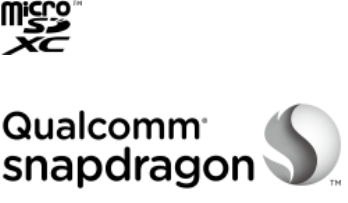
1
LEGAL INFORMATION
Copyright © 2017 ZTE CORPORATION.
All rights reserved.
No part of this publication may be quoted, reproduced,
translated or used in any form or by any means, electronic or
mechanical, including photocopying and microfilm, without the
prior written permission of ZTE Corporation.
Notice
ZTE Corporation reserves the right to make modifications on
print errors or update specifications in this guide without prior
notice.
We offer self-service for our smart terminal device users.
Please visit the ZTE official website (atwww.ztedevice.com)
for more information on self-service and supported product
models. Information on the website takes precedence.
Disclaimer
ZTE Corporation expressly disclaims any liability for faults and
damages caused by unauthorized modifications of the
software.
Images and screenshots used in this guide may differ from the
actual product. Content in this guide may differ from the actual
product or software.
Trademarks
ZTE and the ZTE logos are trademarks of ZTE Corporation.
Google and Android are trademarks of Google, Inc.
The Bluetooth® trademark and logos are owned by the
Bluetooth SIG, Inc.and any use of such trademarks by ZTE
Corporation is under license.
microSDXCLogois a trademark of SD-3C, LLC.
Qualcomm® Snapdragon™ processors are products of
Qualcomm Technologies, Inc.
Qualcomm and Snapdragon are trademarks of Qualcomm
Incorporated, registered in the UnitedStates and other
countries. Used with permission
Manufactured under license from Dolby Laboratories. Dolby,
Dolby Atmos, and the double-D symbol are trademarks of
Dolby Laboratories.
Other trademarks and trade names are the property of their
respective owners.
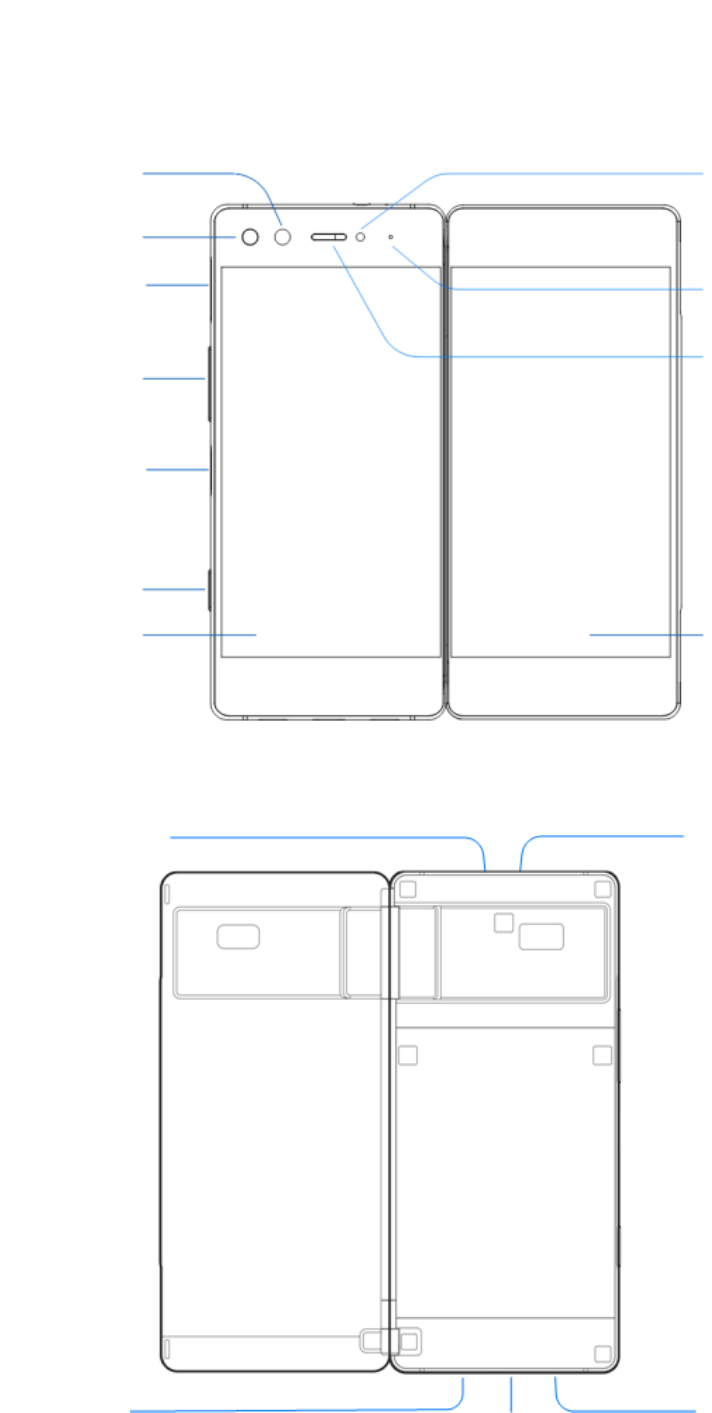
2
Getting to Know Your Phone
Auxiliar
y
micro
p
hone
Left screen Right screen
Volume key
Power ke
y
& fin
g
erprin
t
senso
r
nano-SIM/
microSDHC
card slot
Flash
Camera Proximity
& light sensor
Indicator li
g
ht
Ear
p
iece
Quic
k
lunch ke
y
Charging/
micro-USB
jack
Microphone
Headset
j
ack
speakerphone
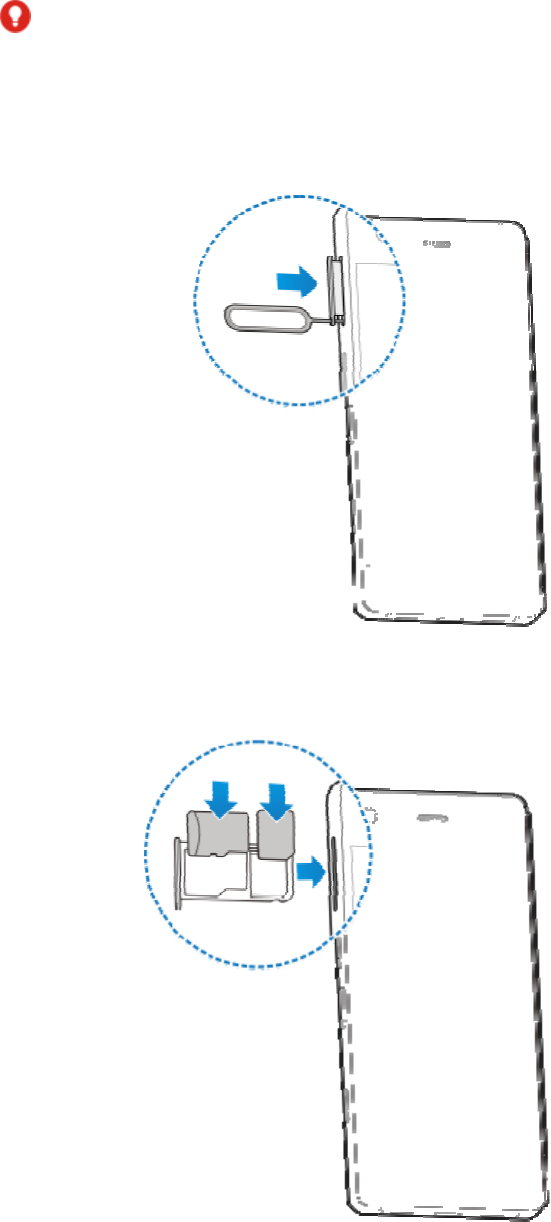
Installing
microSD
X
The nano-SI
M
phone is turn
e
WARNIN
G
To avoid dam
a
SIM cards, or
card. You can
provider.
3
the nano-SIM
c
X
C™ Card (Op
t
M
card can be install
e
e
d on.
G
!
a
ge to the phone, d
o
any non-standard n
a
get a standard nan
o
c
ard and the
t
ional)
e
d or removed while
t
o
not use any other k
a
no-SIM card cut fro
m
o
-SIM card from your
t
he
ind of
m
a SIM
service
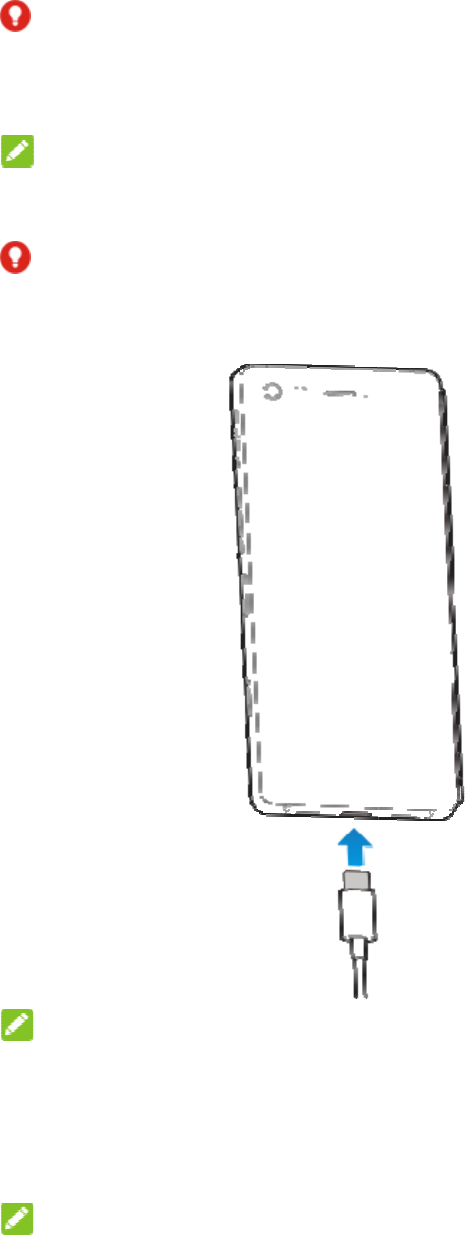
Charging
Your phone’s
b
to turn on, fin
d
charge the ba
WARNIN
G
Use only ZTE
-
The use of un
or cause the b
a
NOTE:
Use the char
g
the battery. It’
s
WARNIN
G
Do not remo
v
removable.
R
NOTE:
If the battery i
s
the phone ev
e
again after ch
a
the customer
s
after prolong
e
NOTE:
If the screen f
r
and holding t
h
10seconds to
4
the Phone sp
e
b
attery should have
e
d
a signal, and make
ttery as soon as pos
G
!
-
approved chargers
a
approved accessori
e
a
ttery to explode.
g
er that comes in-bo
x
s
specially built to su
G
!
v
e the back cover.
T
R
emoval may cause
s
extremely low, you
e
n when it is being c
h
a
rging the phone for
s
ervice if you still ca
n
e
d charging.
r
eezes or takes too l
o
h
e Power/Fingerpri
n
restart the phone.
e
ak
e
nough power for th
e
a few calls. You sho
sible.
a
nd USB Type-C ca
b
e
s could damage yo
u
x
with your phone to
pport QuickCharge
3
T
he battery is not
fire or explosion.
may be unable to p
o
h
arged. In this case,
at least 20 minutes.
C
n
not power on the p
h
o
ng to respond, try
p
n
t senorkeyfor abou
t
e
phone
uld fully
b
les.
u
r phone
charge
3
.0.
o
wer on
try
C
ontact
h
one
p
ressing
t
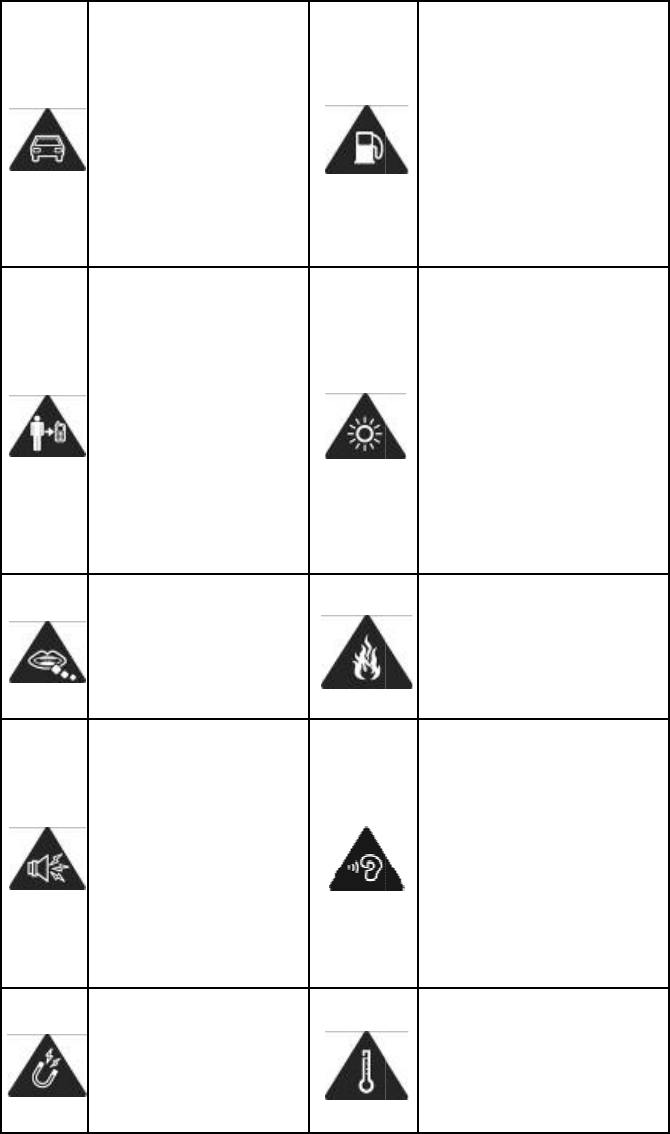
Produ
Infor
m
Gener
a
Don’
t
recei
hand
whil
e
Nev
e
whil
e
Kee
p
pho
n
10
m
from
bod
y
mak
i
Sma
may
cho
k
You
r
can
p
loud
A
voi
d
with
mag
n
5
ct Safet
y
m
ation
a
l Safety
t
make or
ve
held calls
e
driving.
e
r text
e
driving.
p
your
n
e at least
m
m away
your
y
while
i
ng calls.
ll parts
cause
k
ing.
r
phone
p
roduce a
sound.
d
contact
anything
n
etic.
y
Don’t use at
g
stations.
Your phone
m
produce a bri
g
or flashing lig
h
Don’t dispos
e
your phone i
n
fire.
To prevent
possible hea
r
damage, do
n
listen at high
volume level
s
long periods.
A
void extrem
e
temperatures
g
as
m
ay
g
ht
h
t.
e
of
n
r
ing
n
ot
s
for
e
.
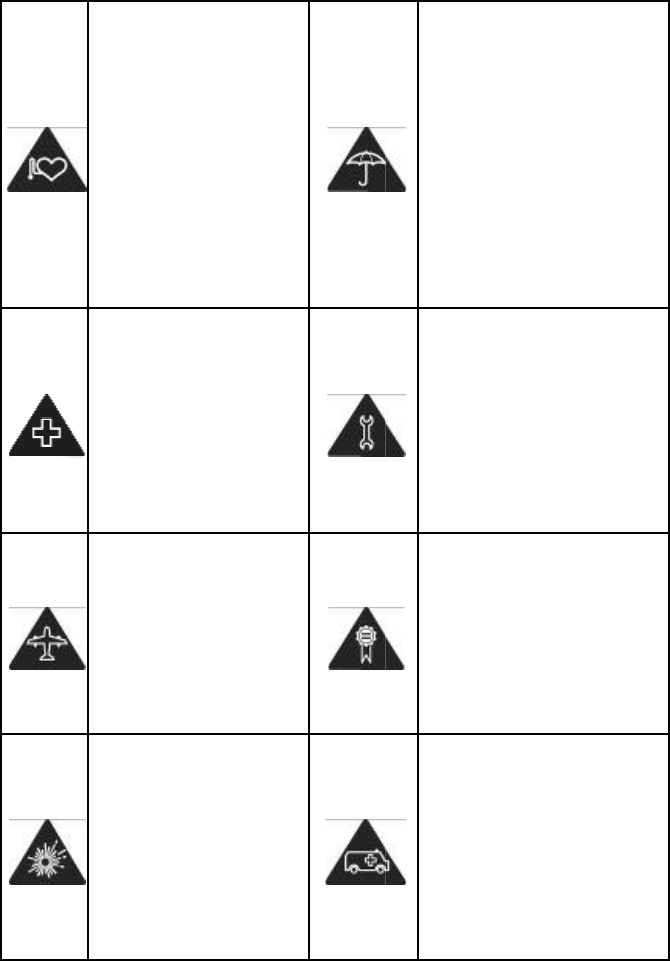
Kee
p
from
pac
e
and
o
elec
t
med
i
devi
c
Turn
ask
e
hos
p
med
i
facili
Turn
told
t
aircr
a
airp
o
Turn
near
mat
e
liqui
d
Radio
F
This phone
exceed the
frequency
(
Communic
a
States.
During SA
R
transmit at
tested freq
u
that simula
t
head with
n
the separa
t
6
p
away
e
makers
o
ther
t
ronic
i
cal
c
es.
off when
e
d to in
p
itals and
i
cal
ties.
off when
t
o in
a
fts and
o
rts.
off when
explosive
e
rials or
d
s.
F
requenc
y
is designed an
d
emission limits
f
(
RF) energy set
b
a
tions Commissi
R
testing, this de
v
its highest certifi
u
ency bands, an
t
e RF exposure
i
n
o separation, a
n
t
ion of 10mm. Al
t
A
void contac
t
with liquids.
Keep your
phone dry.
Do not attem
p
to disassemb
l
your phone.
Only use
approved
accessories.
Don’t rely on
your phone a
s
primary devic
for emergenc
y
communicati
o
y
(RF) Ene
d
manufactured
n
f
or exposure to r
b
y the Federal
on of the United
v
ice was set to
ed power level i
n
d placed in posi
t
i
n usage against
n
d near the body
t
hough the SAR
t
p
t
l
e
s
a
e
y
o
ns.
rgy
n
ot to
adio
n
all
t
ions
the
with
is
7
determined at the highest certified power level,
the actual SAR level of the device while operating
can be well below the maximum value.
This is because the phone is designed to operate
at multiple power levels so as to use only the
power required to reach the network. In general,
the closer you are to a wireless base station
antenna, the lower the power output.
The exposure standard for wireless devices
employing a unit of measurement is known as the
Specific Absorption Rate, or SAR. The SAR limit
set by the FCC is 1.6 W/kg.
This device is complied with SAR for general
population /uncontrolled exposure limits in
ANSI/IEEE C95.1-1992 and had been tested in
accordance with the measurement methods and
procedures specified in IEEE1528.
The FCC has granted an Equipment
Authorization for this model phone with all
reported SAR levels evaluated as in compliance
with the FCC RF exposure guidelines. SAR
information on this model phone is on file with the
FCC and can be found under the Display Grant
section of www.fcc.gov/oet/ea/fccid after
searching on FCC ID: SRQ-Z-01K.
For this device, the highest reported SAR value
for usage against the head is 1.485W/kg, for
usage near the body is 1.493W/kg.
While there may be differences between the SAR
levels of various phones and at various positions,
they all meet the government requirements.
SAR compliance for body-worn operation is
based on a separation distance of 10 mm
between the unit and the human body. Carry this
device at least 10 mm away from your body to
ensure RF exposure level compliant or lower to

the reporte
d
operation,
c
do not con
t
separation
your body.
RF exposu
r
accessory,
and certifie
accessory
s
FCC R
e
This devic
e
Rules. Op
e
conditions:
interferenc
e
interferenc
e
may cause
CAUTI
Changes o
r
by the man
authority t
o
The anten
n
be co-locat
other ante
n
NOTE
:
This equip
m
comply wit
h
pursuant t
o
These limit
s
protection
a
residential
i
uses and c
a
if not instal
l
instruction
s
radio com
m
8
d
level. To supp
o
c
hoose the belt
c
t
ain metallic com
of
10
mm betw
e
r
e compliance w
which contains
m
d, and using su
c
s
hould be avoid
e
e
gulation
s
e
complies with
p
e
ration is subject
(1) This device
m
e
, and (2) this d
e
e
received, inclu
d
undesired oper
a
ON:
r
modifications n
ufacturer could
v
o
operate the eq
u
n
a(s) used for thi
s
ed or operating i
n
na or transmitte
:
m
ent has been t
e
h
the limits for a
C
o
part 15 of the F
s
are designed t
o
a
gainst harmful i
n
i
nstallation. This
a
n radiate radio
f
l
ed and used in
a
s
, may cause ha
r
m
unications. Ho
w
o
rt body-worn
c
lips or holsters,
ponents, to mai
n
e
en this device a
n
ith any body-wo
r
m
etal, was not t
e
c
h body-worn
e
d.
s
p
art 15 of the FC
C
to the following
t
m
ay not cause h
a
e
vice must acce
p
d
ing interferenc
e
a
tion.
ot expressly ap
p
v
oid the user’s
u
ipment.
s
transmitter mu
s
n conjunction wi
t
r.
e
sted and found
C
lass B digital d
e
CC Rules.
o
provide reaso
n
n
terference in a
equipment gen
e
f
requency energ
y
a
ccordance with
r
mful interferenc
e
w
ever, there is n
o
which
n
tain a
n
d
r
n
e
sted
C
t
wo
a
rmful
p
t any
e
that
p
roved
s
t not
t
h any
to
e
vice,
n
able
e
rates,
y
and,
the
e
to
o
9
guarantee that interference will not occur in a
particular installation. If this equipment does
cause harmful interference to radio or television
reception, which can be determined by turning
the equipment off and on, the user is encouraged
to try to correct the interference by one or more of
the following measures:
• Reorient or relocate the receiving antenna.
• Increase the separation between the equipment
and receiver.
• Connect the equipment into an outlet on a
circuit different from that to which the receiver is
connected.
• Consult the dealer or an experienced radio/TV
technician for help.
Distraction
Driving
Full attention must be given to driving at all
times in order to reduce the risk of an accident.
Using a phone while driving (even with a hands
free kit) can cause distraction and lead to an
accident. You must comply with local laws and
regulations restricting the use of wireless
devices while driving.
Operating Machinery
Full attention must be given to operating the
machinery in order to reduce the risk of an
accident.
10
Product Handling
General Statement on Handling
and Use
You alone are responsible for how you use your
phone and any consequences of the use.
You must always switch off your phone wherever
the use of a phone is prohibited. Use of your
phone is subject to safety measures designed to
protect users and their environment.
• Always treat your phone and its accessories
with care and keep them in a clean place.
• Keep the screen and camera lens clean.
Unclean screen or camera lens may slow
down the phone's reaction to your operations
or lower image quality.
• Clean your phone and its accessories with a
soft material such as cleaning cloth for
eyeglass lenses. Do not use alcohol or other
corrosive substances for cleaning or allow
them to get inside.
• Do not expose your phone or its accessories
to open flames or lit tobacco products.
• Do not expose your phone or its accessories
to liquid, moisture or high humidity.
• Do not drop, throw or try to bend your phone
or its accessories.
• Do not use harsh chemicals, cleaning
solvents, or aerosols to clean the device or its
accessories.
• Do not paint your phone or its accessories.
• Do not attempt to disassemble your phone or
its accessories, only authorized personnel can
do so.
11
• Do not expose or use your phone or its
accessories in an environment with or that
can reach extreme temperatures, minimum 23
℉ and maximum 122 ℉ (minimum - 5 ℃ and
maximum + 50 ℃).
• Do not place your phone inside or near
heating equipments or high pressure
containers, such as water heaters, microwave
ovens, or hot cooking utensils. Otherwise,
your phone may be damaged.
• Please check local regulations for disposal of
electronic products.
• Do not carry your phone in your back pocket
as it could break when you sit down.
Small Children
Do not leave your phone and its accessories
within the reach of small children or allow them to
play with it.
They could hurt themselves or others, or could
accidentally damage the phone.
Your phone contains small parts with sharp
edges that may cause an injury or may become
detached and create a choking hazard.
Demagnetization
To avoid the risk of demagnetization, do not allow
electronic devices or magnetic media close to
your phone for a long time.
Electrostatic Discharge (ESD)
Do not touch the metallic connectors of the
micro-SIM card.
12
Antenna
Do not touch the antenna unnecessarily.
Normal Use Position
When placing or receiving a phone call, hold your
phone to your ear, with the bottom toward your
mouth.
Air Bags
Do not place your phone in the area over an air
bag or in the air bag deployment area as an
airbag inflates with great force and serious injury
could occur.
Place your phone safely before driving your
vehicle.
Seizures/Blackouts
Your phone can produce a bright or flashing light.
A small percentage of people may be susceptible
to blackouts or seizures (even if they have never
had one before) when exposed to flashing lights
or light patterns such as when playing games or
watching videos. If you have experienced
seizures or blackouts or have a family history of
such occurrences, please consult a physician.
To reduce the risk of blackouts or seizures, you
can use your phone in a well-lit room and take
frequent breaks.
Repetitive Strain Injuries
To minimize the risk of Repetitive Strain Injury
(RSI) when texting or playing games with your
phone:
• Do not grip the phone too tightly.
• Press the buttons lightly.
13
• Use the special features which are designed
to minimize the times of pressing buttons,
such as Message Templates and Predictive
Text.
• Take frequent breaks to stretch and relax.
Emergency Calls
This phone, like any other wireless phone,
operates using radio signals, which cannot
guarantee connection in all conditions. Therefore,
you should not rely solely on any wireless phone
for emergency communications.
Loud Noise
This phone is capable of producing loud noises,
which may damage your hearing. Turn down the
volume before using headphones, Bluetooth
headsets or other audio devices.
Phone Heating
Your phone may become warm during charging
and normal use.
Electrical Safety
Accessories
Use only approved accessories.
Do not connect with incompatible products or
accessories.
Take care not to touch metallic objects, such as
coins or key rings, or allow them to contact or
short-circuit the charging jack terminals.
Never puncture the surface of the phone with
sharp objects.
14
Connection to a Car
Seek professional advice when connecting a
phone interface to the vehicle electrical system.
Faulty and Damaged Products
Do not attempt to disassemble the phone or its
accessories.
Only qualified personnel can service or repair the
phone or its accessories.
If your phone (or its accessories) has been
submerged in water, punctured, or subjected to a
severe fall, do not use it until you have taken it to
be checked at an authorized service center.
Radio Frequency Interference
General Statement on Interference
Care must be taken when using your phone in
close proximity to personal medical devices, such
as pacemakers and hearing aids.
Please consult your doctor and the device
manufacturers to determine if the operation of
your phone may interfere with the operation of
your medical devices.
Pacemakers
Pacemaker manufacturers recommend that a
minimum separation of 15 cm be maintained
between a mobile phone and a pacemaker to
avoid potential interference with the pacemaker.
To achieve this, use the phone on the opposite
ear to your pacemaker and do not carry it in a
breast pocket.
15
Hearing Aids
People with hearing aids or other cochlear
implants may experience interfering noises
when using wireless devices or when one is
nearby.
The level of interference will depend on the type
of hearing device and the distance from the
interference source, increasing the separation
between them may reduce the interference.
You may also consult your hearing aid
manufacturer to discuss alternatives.
Medical Equipment
Switch off your wireless device when you are
requested to do so in hospitals, clinics or health
care facilities. These requests are designed to
prevent possible interference with sensitive
medical equipment.
Aircraft
Switch off your wireless device whenever you
are instructed to do so by airport or airline staff.
Consult the airline staff about the use of wireless
devices on board the aircraft and enable
airplane mode of your phone when boarding an
aircraft.
Interference in Vehicles
Please note that because of possible
interference to electronic equipment, some
vehicle manufacturers forbid the use of mobile
phones in their vehicles unless a hands-free kit
with an external antenna is included in the
installation.
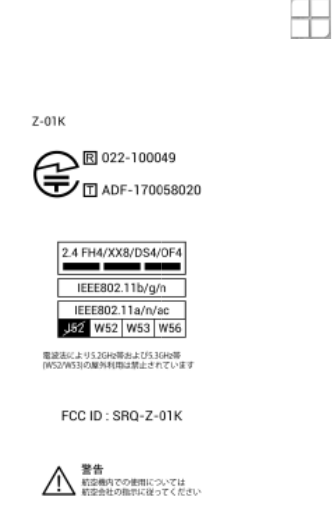
Explo
s
Statio
n
Atmos
p
In location
s
pheres, ob
e
devices su
c
equipment
.
A
reas with
include fu
e
fuel or che
m
areas whe
r
particles, s
Blastin
g
Power off
y
when in a
b
are posted
“electronic
blasting o
p
Enquei
r
In home scr
e
E-label certi
16
s
ive Envir
o
n
s and Ex
p
p
heres
s
with potentiall
y
e
y all posted si
g
c
h as your pho
n
.
potentially expl
o
e
lling areas, bel
o
m
ical transfer o
r
r
e the air contai
n
uch as grain, d
u
g
Caps and
A
y
our mobile pho
n
b
lasting area or
to power off “t
w
devices” to avo
i
p
erations.
r
ing the E-l
a
e
en, touch >Se
t
ficate.
o
nmentsG
a
p
losive
y
explosive atm
o
g
ns to turn off wi
n
e or other radio
o
sive atmosphe
r
o
w decks on bo
a
r
storage faciliti
e
n
s chemicals or
u
st, or metal po
w
A
reas
n
e or wireless d
e
in areas where
s
w
o-way radios” o
i
d interfering wit
a
bel
t
tings >About ph
o
a
s
o
s-
reless
r
es
a
ts,
e
s,
w
ders.
e
vice
s
igns
r
h
o
ne>